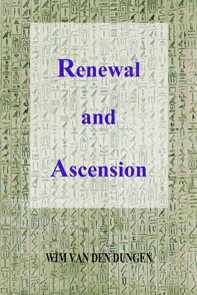3 Approaching Nun.
The stellar naturalism put into evidence by the architecture of the pyramids is
also found in the literature they have immortalized. Early Egyptian thought caught the natural, impersonal
differential (the outstanding difference with its co-relative energy
potential). Its aim was to understand all the forces and elements of
nature, the "totality" of creation. In ante-rational thought, especially
in its incipient stage, confuses personal and objective conditions. This
leads to the personalization of natural process. Like "Nun", "the gloomy infinity of dark
water" (Traunecker,
2001, p.73), "Nut", "Geb", "Maat", "Re", "Ptah" and "Amun" are other
examples of impersonal archetypes of nature promoted to imaginal godforms,
namely sky, Earth, order, light, artefaction and hiddenness respectively.
"... the Egyptians lived in a universe composed not of things, but
of beings. Each element is not merely a physical component, but a
distinct individual with a unique personality and will. The sky is not an
inanimated vault, but a goddess who conceives the sun each night and gives
birth to him in the morning. The atmosphere that separates sky from earth
is not an empty void, but a god. The Duat is not merely a mysterious
region through which the sun passes at night, but the god Osiris. Even the
vast and lifeless outer waters have an identity, as the god Nu." -
Allen, 1988, p.8.
Like in many other cases,
the notion of precreation, given a special virtual adverb clause, involved
a conceptualization, in
strong imaginal thought, of a common physical process, in this case, the facts
of water
surging up as the result of the water table of the alluvial plain of the Nile
and rain falling down through "leaks" in the sky. It was
also linked with the source of the Nile, and the dynamics of the
inundation, with its dangerous extremes. The idea
conveyed is simple : from the outside as well as from the inside, creation
is surrounded by the original
primordial state of this primordial, preexistent and everlasting inert,
watery darkness, and this in all directions and all the
time. In Egyptian thought, this liquid space is not a focus of creative
light, but a vast chaos, like a gloomy night and an limitless expanse.
Nun is a threatening state of affairs into which order could relapse at
any moment. It is the opposite of order, light and life. In fact, the
cosmos, or ordered natural whole, is constantly balancing "on the edge" of
this abyss of chaos, although periods of extended peace are possible. The
constant war of the forces and the elements (divine & human) does not lead
to the destruction of the world, because, for its safeguard, "truth and
justice" are offered to its creator. Because the laws of the eternal cycle
of Re are respected, creation will endure, despite Nun, and as long as
Atum wills creation.
Nonexistent precreation, or the omnipresence of an everlasting,
pre-existent, virtual state-of-no-state, is the first concept of
traditional Egyptian theology, as evidenced by its founding
role in the Heliopolitan, Memphite, Hermopolitan, Osirian & Theban
branches of Egyptian thought. Each branch is an approach of
"He-whose-Name-is-Hidden" characterized by a single principle.
In the Old Kingdom, the
monolatry of the structure is evident
(each single principle is identified with the "great god").
Pre-rationality does not provide the
tools to solve this issue. In the Middle Kingdom, when proto-rational
thought becomes "classical", Theban theology starts with its henotheist
project, culminating, at the end of the New Kingdom, in
Atenite and
Amenite theology.
-
Heliopolis : Atum (Re),
the principle of light, presence, autogenous activity,
self-consciousness, the Lord of the sky ;
-
Memphis : Ptah, the
principle of constructive thinking, artefaction, the making of things by
means of practical mental activity (heart together with tongue) is the
Beautiful of Face ;
-
Hermopolis : Thoth, the
principle of creative, healing, magical thinking, ritual, the counting and
accounting of things by means of organized schemes, the Lord of Time ;
-
Abydos : Osiris, the
principle of life, death, rebirth, rejuvenation, funerary and regenerative
rituals, Lord of the Duat ;
-
Thebes : Amun (Re), the
principle of divine transcendence and immanence, the King of the Gods.
Although ontologically, precreation
is isomorphic, homogeneous, unknown, insubstantial, void, undifferentiated
and without organization, the need to characterize it is
already felt in the Pyramid Texts.
These authors
approach Nun by giving negative descriptions of the non-presences based
on the real (a cosmo-teleological procedure of sorts). The terra firma
of Earth is opposed to the liquid, dark, nocturnal nature of Nun.
In the Coffin Texts of the Middle Kingdom (ca. 1938 - 1759 BCE), four entities represent
the unorganized : Nun (water), Hehu (liquid space), Keku (darkness) and
Tenmu (disorder). The positive descriptions of creation, namely solidity,
delimitation, light, nearness and knowledge are reversed : liquid,
infinite space, dark, hidden and the unknown.
► linguistics : the virtual clause
In the Old Kingdom (ca. 2670 - 2198 BCE), the virtual clause "n SDmt.f", i.e. "before he has
(had) ..." or "he has (had) not yet ..." (Gardiner,
§ 402), was used to denote a prior, potential nonexistent state, namely
one before the actuality of that state had happened. To be
nonexistent, precludes existence, but does not preclude the possibility
of becoming existent (expressed by the verb "kpr", "kheper", "to become", which
also means "to transform").
Examples of this virtual clause are : "I am sorry for her children, I grieve for her children
broken in the egg, who have seen the face of Khenty (the crocodile-god)
before they have lived !" (in Discourse
of a Man with his Ba) or "... do not rejoice over what has not
(yet) happened." (cf. "m Haw n ntt n xprt" in The Eloquent Peasant,
a Middle Kingdom text).
►
the virtual clause applied to precreation
There is something
before every thing, before the order, the architecture and the life
of creation, manifested as a transformation or change from a nonexistent,
virtual state to an existing actuality.
The virtual state is not actual, but confirms possibility, latency and
potentiality. As a potency anterior to
creation, it was conceived as a nonexistent object, before "form", i.e.
anterior to space and time, and
before the creation of sky, Earth, horizon and their "natural"
dynamics. In the Pyramid Texts, Pharaoh is said to originate from beyond
the natural order, beyond creation of space (Shu) and moist (Tefnut), sky
(Nut) and Earth (Geb), life and order.
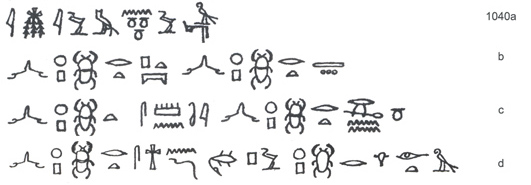
"I was
born in Nun before the sky existed, before the Earth existed, before that
which was to be made form existed, before turmoil existed, before that
fear which arose on account of the Eye of Horus existed."
Pyramid Texts, utterance 486.
"I was conceived in Nun. I was born in Nun. I have come and I have
brought to You the bread which I found there."
Pyramid Texts, utterance 211.
►
semantics and variant writings
Precreation was imagined as a limitless, everlasting water (sea or ocean), called by various
names : "nw" (Nu), "nww" (Nuu), "nnw" (Nenu), "nnww"
(Nenuu), "nnnww" (Nenenuu), "niw" (Niu).
In the Pyramid Texts, "nnw(w)" (Nenu) is the most frequent form
(22/30). The core sound, the biliteral "nw", was vocalized in Coptic as
"Noyn" or "Noun" ("Y" = "U"), from which the English "Nun" has been
derived. Two distinct forms of the name exist, namely, on the one
hand, "nw", "nww" and "niw",
and on the other hand, "nnw", "nnww" and "nnnww".
The Pyramid Texts invite us to make the difference between :
-
the impersonal
description of precreation, as in "nw", "nww", "nnw", "nnww" and "nnnww"
: this is the natural differential founding Egyptian thought,
namely an endlessly vast expanse of water. It does not verge upon or tend towards
manifestation, actualization, materialization, realization, spatialization
and temporalization. This expanse encloses every thing : the sky, the
Earth and the netherworld, this dark realm of the night, the dead and the
Ars Obscura ;
-
the
male personification of "nw", as "niw" : in two cases Nun is
personalized : Pharaoh is called to "succeed to the thrones of Niu" (§
2) and in
§ 9, Niu is paired with his female
consort "nnt", "Nenet" (this was vocalized by the Greeks as "Nauni" or
"Naunet"). As in
§ 26
"nnt" and "nw" are coupled, we may safely translate "nw" and "niw" both as
"Nun" ;
-
the
female personification of "nw", the so-called "lower sky", as in "nt" and
"nnt" : the primeval waters are also present below the Earth. These
waters are in the deep of the netherworld. Situated beyond the Duat, which
is still part of creation, they nevertheless are the source of the Nile on
Earth. This deep sky has been translated as "lower sky", and
appears as the feminine counterpart of "nw", n(w)t, mostly written as
"nt", with the determinatives for place (O49) and the reversed vault of
the sky (A40), suggestive of the "lower" counterpart of the
"normal" upper (diurnal) sky.
This reversal of the vault of heaven is suggestive of the complete
enclosure of the netherworld by preexisting nonexistence. In one case only is
this inversion of the vault of the sky part of the writing of the
masculine "nw", namely in the pyramid of Merenre (cf.
§ 21).
A scribal error ?
Like the masculine forms of the name, "nw" and "niw", the two feminine
forms ("nt" and "nnt") refer to the same entity : Nun. In the
Pyramid Texts, confusion ensues between this deep, precreational sky
and the sky of the Osirian netherworld (for this lower sky and the
"Imperishable Stars" are identified). Only later theologies clarify this.
In New Kingdom texts (like from the cenotaph of Seti I), the Nun is deemed
"unknown", whereas the Duat or netherworld is included among the elements
of the known world. Perhaps the imperishables are the created gates
leading to the uncreated "deep" sky of the netherworld (the
potential kept by precreation) ?
The lower sky as "nt" is mentioned in four Utterances, and in all cases it
is translated as "lower sky" :
Utterance 214 - § 149 :
"You demand that You descend to the lower sky and
You shall descend ..."
Utterance 570 - §§ 1456 - 1458 (3 identical clauses) :
"I live beside You, (O) You gods of the lower sky,
the Imperishable Stars ..."
Utterance 571 - §§ 1466 - 1467 :
"The King's mother was pregnant with him, (even he)
who was in the lower sky, the King was fashioned by his father Atum before
the sky existed, before Earth existed, before men existed, before the gods
were born, before death existed."
Utterance 574 - § 1485 :
"Hail to You, You tree which encloses the god, under
which the gods of the lower sky stand, the end of which is cooked, the
inside of which is burnt, which sends out the pains of death : may You
gather together those who are in Nun, may You assemble those who are in
the celestial expanses."
A second spelling also appears ; "nnt" starts with two rushes of shoots
(M22) or "nn", followed by the phonetical complement "n" and "t", also
ending with the determinatives for village, town (O49) and the reversed
vault of the sky (A40). In a few instances, O49 is dropped. The context
allows us to translate "nnt" in two cases as "Naunet", the female consort
of Nun.
The lower sky as "nnt" is mentioned in five Utterances, and in two the
context (coupling) allows us to translate as "Naunet" :
Utterance 218 - § 166 :
"This King comes indeed, importuning the Nine, an
imperishable spirit, and those who are in the lower sky belong to this
King."
Utterance 222 - § 207 :
"Cast off your impurity for Atum in Heliopolis and {descend}
together with him. Judge the needs
of the lower sky and succeed to the thrones of Nun."
Utterance 301 - § 446 :
"To say : You have your offering-bread, O Nun together with Naunet, You
two {protectors}
of the gods, who protect the gods with your shadow."
Utterance §§ 1345 - 1346 :
"He goes aboard the bark like Re at the banks
of the Winding Waterway, this King rows in the Bark of Lightning, he
navigates therein to the Field of the Lower Skies at this south of the
Field of Rushes."
Utterance 606 - § 1691 :
They set Shu for You on your East side and Tefnut on your West side, Nun
on your South side and Naunet on your North side. They guide You to these
fair and pure seats of theirs which they made for Re when they set him
upon their thrones."
The variant writings of
the name give us additional visual semantics : the phonetic core of the impersonal
(masculine) forms, W24, the so-called
"Nun-bowl", is used three times, a plural : plenty of water, a
mass. In the Pyramid Texts, W24 is topped by N35, a ripple of water. In
two cases, two ripples are drawn (utterances 503 & 627). A lot is
apparently not enough to describe the condition at hand. In four
cases, the determinative for gods (Horus on a standard, G7) is added :
a divine condition.
In the Coffin Texts,
variant spellings emerge, and the impersonal principle, more frequent in the
Pyramid Texts, is personalized by using the determinative of the seated
god (A40), absent in the latter.

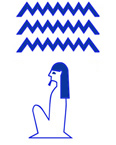

"Nun" in the
Coffin Texts, Utterances 76 and 334, and a later spelling.
This personalization goes
hand in hand with the introduction of the hieroglyph of
the vault of the sky (N1), underlining a fundamental barrier between creation and
Nun. The rim of the sky in particular, refers to the unchanging region of
the circumpolar stars, in the Field of Offering, beyond which Nun lies dormant and
inert.
Nun : divine chaos and lifeless water as the milieu
of creation and the world
In the ontology sketched in the Pyramid Texts, precreation is in
the first place an undifferentiated mass of water. Only two personal instances
occur, namely the coupling of "Niu" with "Naunet" in §§ 2
& 9.
In
§ 26, "Naunet" and "Nun" are
paired. The Egyptians gave discriptive rather than denominative
qualifications. Nun is conceived as an inchoate, nonexistent
state-of-no-state.
But, the ontology of precreation involves an ambivalence : precreation is both
the source of regeneration (first cause of creation)
and a threatening chaos, for its darkness, death and disorder encapsulate
creation from all sides and all the time. Like the floods of the Nile, Nun was both origin of life (thanks
to a
"good Nile" with a balanced inundation) and cause of death (after long periods
of too much or too little floodwater). Hidden in the deep and in the far,
chaos surges up from under our feet and leaks in as rain falling on our heads from the sky. Its
non-presences cannot be escaped, except to our peril. As the flood, it is
a chaotic factor, implying that although its cycle can be mapped, it is
impossible to determine the outcome of the function for any given place
and date.
In the Coffin Texts and later, Nun is
often depicted as a deity, and
although no cult is attested, there were offerings and feasts in his honor
(as on the 18th & 19th day of the month of Phamenoth).
The vault conveyed a topological difference : not only was precreation
something different (namely darkness and a nonexistent potential surrounding the
cosmos), but it was also somewhere else.
Precreation and creation are separated from
each other.
"King Neferkare is a great falcon which is on the battlements of Him-whose-Name-is-Hidden, taking what belongs to Atum to Him who separates the sky from
the Earth and Nun."
Pyramid Texts, utterance 627.
A large mass of water higher than the sky and deeper than the netherworld
is the image conveyed. This virtual realm of the nonexistent is beyond the
subtle, invisible strata of creation, beyond the sky and underneath the
netherworld. The sky is a double vault, protecting creation from above and
from below, shielding it from the omnipresent Nun (W24 is also present in
the name of Nut, "nwt", the goddess of the sky),
"who gives birth to the Sun every day" (Pyramid
Texts, § 1688).
The double vault of
heaven is topped by an everlasting limitless mass of potential energy,
inimical to light, order and life. It is not kenetic and not creative.
"God said, 'Let there be a vault through the middle
of the waters to divide the waters in two.' And so it was.
God made the vault, and it divided the waters under the vault from the
waters above the vault. God called the vault 'heaven'."
Genesis,
1:6-7.
|

|
The green risen Earth (the outcome
of the creative process - cf. infra) is surrounded
by the limitless expanses of the primordial waters,
permeating everything, and hidden from immediate sight. The cycle of the
Sun with its horizon, divides this risen land in a diurnal and a nocturnal
cycle.
The sky separates Nun from the Earth. The diurnal sky and the sky of the
netherworld share in the
watery nature of the limitless ocean, but this water is not infinite but
navigated by the stars, the deities, the spirits and Re, both during the day as at
night, both in the sky of Re as in the sky of Osiris.
Of all stars of the sky, the circumpolar stars are imperishable. They
stand at the rim of the sky and hence near the gates of precreation. Are they
portals to escape creation and its natural cycle ? Where to ? Not to Nun. |
Chaos being the foundation of every thing, more than a virtual clause is
needed to understand how creation happened and how the natural
relationships with Nun are, for this "darkness and night" is
also the milieu of the
matrix of light, order and life.
►
before creation : Nun : the container or milieu of the "Lord of Life"
In precreation,
nonexistence and nothingness are not
identical. To be nonexistent is obviously to preclude actuality, but in
Egyptian thought it
never precludes the potentiality to come into existence, to become,
transform or transmute. The latter is indicated by the verb "kpr",
"Kheper". Hence, besides chaotic Nun, precreation also effectuates the
capacity of autogenous creation or self-creation.
The issue of autogenous activity is another important concept. Chaos is
not the origin of order. Light and life are spontaneous and without any
possible determination. Precreation is the conjunction of Nun and the
sheer possibility of something preexisting as a nonexistent, virtual
singularity. Precreation is the dual-union of Nun and Atum, of
infinite energy-field and primordial atom.
Creation emerges from a monad, floating "very weary"
(CT, utterance 80) in the dark, gloomy, lifeless infinity of
Nun. Within the omnipresent substance of Nun, the possibility of order, light and life subsisted : a
nonexistent object capable of self-creation ex nihilo. Hence,
although Nun is nowhere and everywhere, never and always, it is the
primordial, irreversible and everlasting milieu in which the eternal
potential of creation creates itself.
The state-of-no-state is not identical with nothingness, the void.
For nothingness is absolute zero, as opposed to "virtual" zero,
i.e.
the virtual
(empty) set V = {Ø}. Z = 0 does not define anything, and hence refers to
nothing. Virtual nonexistence holds the possibility of a future ordered series
of elements, i.e. the idea of all
possibility, but absolute zero precludes existence as well as becoming.
Precreation is not the absolute zero of nothing, but the virtual oneness of a
monadic, autogenous potential to complete creation within the milieu of
the limitless waters.
"Les Égyptiens ne rencontrent l'unicité absolue de
dieu qu'en dehors du monde et de la création, durant la transition fugace entre
la non-existence et l'existence. Par ses travaux créatifs, le premier - et à
l'origine le seul dieu, disperse l'unicité primordiale en une multiplicité et
une diversité de manifestations : ainsi, en dépit de multiples
caractéristiques communes, chaque dieu est unique et incomparable." -
Hornung,
1986, p.169, my
italics.
►
during creation : Atum
: he who is a virtual completeness
Atum, who "created what exists" and who is
the "Lord of all things" (CT,
utterance 306), "Lord of All" (CT,
utterance 167), "Lord of Everyting" and
"Lord of Life" (CT, utterance 534), is
"the origin of all the forces and elements of
nature" (Allen,
1988, p.9). His name is a form of the verb "tm", probably a noun of
action, meaning both "complete, finish" and "not be". Indeed, Atum
completes creation without belonging to the created order.
"Sur le plan de la philologique, nous évoluons sur
des bases fermes car des termes égyptiens tels que tm wnn et
nn wn sont sans conteste des négations du verbe 'être' - le premier
refermant un verbe négatif, le dernier une particule. Il y a ausi l'adjectif
relatif négatif (jwtj / jwtt) et un substantif qui en dérive ;
littéralement, ces termes ne peuvent signifier que 'ce qui n'est pas' ou 'ce
que n'existe pas'. Les Égyptiens établissent, en outre, une distinction nette
entre le verbe 'être', 'devenir' et 'vivre'." -
Hornung,
1986, pp.157-158.
Anthes (1957) translates Atum as
"he who is integral",
Bonnet as "he who
is not yet complete".
Kees (1941) opts for
"he who is not present yet" or
"he who does not yet exist completely",
whereas
Hornung (1986) chooses
"he who is differentiated", eliminating the
important connotation of the alternation-point between a mere potential
(in precreation) and its actualization ...
"O Atum, raise this
King Wenis up to You, enclose him within your embrace, for he is your son
of your body for ever."
Coffin Texts, utterance 222 - § 213
"To say : Atum is he who (once) came into
being, who masturbated in Heliopolis. He took his phallus in his grasp
that he might create orgasm by means of it, and so were born the twins Shu
and Tefnut."
Coffin Texts,
utterance 527 - § 1248
"Content is Atum, father of the gods ..."
Coffin Texts,
utterance 576 - § 1521

"To say : Hail to You,
Atum ! Hail to You, Kheprer, the self-created ! May You be high in this
your name of 'Height'. May You come into being in this your name of
Kheprer."
Coffin Texts,
utterance 587 - § 1587
Both Nun and Atum received the epithet "father of the
gods". Everlasting darkness and the
efficient and dynamical, autogenous creativity have to be thought together
and separately. Both form the dual-unity of precreation, the first of a set of equilibrated
scalings, or monuments of opposites in balance (before creation, during
creation, in creation and after creation). Atum spontaneously manifests as
a seed floating in Nun, initiating the divine time of the deities. He
completes creation by generating, before and outside creation, the forces ruling
creation.
►
the first occurrence
A third major concept besides Nun and Atum is introduced : the "zep tepi"
or "first occurrence". It stand between the moment of Atum's self-creation
and the emergence of actuality (as Earth, sky and horizon).
Atum creates Atum on the first moment of the "zep tepi" ("zp tpi"),
the "first occurrence" or "first time". Before that moment, no order,
light or life preexisted. Precreation and Nun coincided. But on this instance, the patterns of existence
were
established and enacted. Creation was thus initiated by the distinction
between the surrounding waters (Nun) and the primordial seed. Atum creates
himself ex nihilo. He is not a transformation of a previous state.
Nun is not changed because of Atum. Before this monad self-created,
lifeless nonexistence prevailed. With this monad, nonexistence is divided
into the chaotic waters and the seed of order, light and life. Atum
represents the spontaneous potential of precreation to manifest creation,
and because Atum self-creates, there is nothing anterior to this monad,
except the liquid space of disorder and darkness.
This difficult notion is touched upon in this remarkable text :
"I am Nun, the sole one, without equal. That is
where I (Atum) came into being on the
great occasion of my
floating when I came into being. I am he who flew up, who came into being
{...} who is in his egg. I am the one who began therein, (in) the Nun, and
see : the chaos-gods came out of me, see, I am hale. I brought my power
into being through my power. I am the one who made myself and I formed
myself at my will according to my desire. (...)."
Coffin Texts, utterance 714 : the second first person refers to
Atum, not Nun as the rest of the passage makes clear (nowhere is the name
"Atum" mentioned).
Atum creates and completes the world for his own pleasure and according to
his own heart (or divine mind - cf.
Memphite theology). The reason why something came out of Nun is
explained as Atum pleasing himself (the image of masturbation), not
parenthood. Paradoxically, creation starts in precreation. To understand
this, we need another concept, which the Egyptians derived from their
sense of time : the timelessness of the eternal cycle of creation.
|
the Ancient Egyptian view on
time
|
|
Phenomenal Time "of men on
Earth" |
at
("At") |
moment, instant,
small
portion of time, culmination time |
unit of
phenomenal time |
ahau
("aHaw") |
period, space of time,
lifetime, man's age |
collection
of time-units |
|
Eternal time : the
repetition and duration "of the
gods" |
neheh
("nHH") |
timelessness - first
time,
eternity, eternal and
unending repetitions |
Atum-Re, the deities
and the blessed
dynamical, cyclic |
djedet
("Ddt") |
no-time,
to be permanent,
stable, enduring, everlasting |
Nun, the
Ogdoad and the
mysteries of Osiris, static, linear |
With Atum and the first
occurrence, no actual thing is positioned, but only the divine structure
necessary to manifest the real. Indeed, only the formal conditions of
creation are given (i.e. an outline of its elements and forces). Atum as
it were contemplates his creation-to-be "in his heart" before a solid
place emerges (definite forms of matter exist). The "zep tepi" is
the eternity of the
divine mind, the demiurg or architect of creation itself. As such, it is
conceived as outside creation, although it always preludes it.
The first occurrence unfolds at the moment creation starts with the
spontaneous emergence of Atum ex nihilo. Atum's self-generation and
the creation of space ("Shu") and moist ("Tefnut") within the substance of the monad are simultaneous
and take place before actual things come into existence.
Atum autogenerates for his own pleasure and by doing so immediately &
simultaneously gives birth to Shu & Tefnut, the start of a chain of
ordered structures (the Ennead or the sequence {1, 2, 3} U {4, 5} U {6, 7,
8, 9}). This first time is the imaginal continuum of natural
parameters preparing to create and sustain reality. This is the divine mind
with its infinite number of names, attributes and functions.
"... the concept of the Ennead describes the
interrelationships between nine fundamental forces and elements of the
Egyptian universe. Of these, four are primarily operative in the world of
life and death as its exists after the creation. Osiris and Isis, Seth and
Nephthys represent the opposing but balanced principles of order and
disorder, growth and destruction, and the transmission of life."
Allen, 1988, p.8.
With the emergence of "ta-Tenen", the "first land" rising out of
precreation (cf.
the islands emerging after the inundation), i.e. the primordial Earth (cf.
the hypostyle hall in the Egyptian temple), and with the first Sun-ray (of
Horus-Re in the sky) touching it (cf. the Benben as a petrified beam), the first
occurrence is over.
|
Nun |
uncreated
not creating |
precreation |
everlastingness
djedet |
Atum
& Ennead |
uncreated
creating |
eternal first time :
neheh |
Horus, Re
& Pharaoh |
created
not creating |
creation |
phenomenal time |
Atum
& Osiris |
uncreated
creating |
postcreation |
eschatological time |
Atum causa sui means an endless (re)generative capacity rooted
ex nihilo (as "zep tepi") in the boundless chaos of the primordial
ocean, creating everything for its own pleasure. The first occurrence is
timeless & eternal but not everlasting (for given to an eternal cycle of
recurrence).
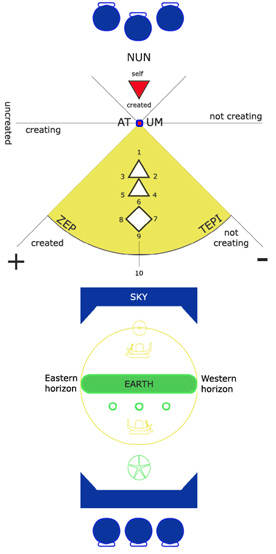
Nun, Atum and creation
4 Everlasting Abyss and eternal Pleroma.
Coptic scholars like
Crum (1939) translate "NOYN" as "abyss of
hell, depth of Earth, sea". So Nun has also been translated as "Abyss" (Faulkner,
Mercer,
Allen).

Coptic "Noun", or "abyss of hell" ...
But precreation is more than an
deadly abyss of liquid, lifeless space. More than a formless mass of
confusion, inert, dark and inimical to order and life. In other words,
precreation is not identical with Nun. Atum, the "Ba" of Nun, or
the co-relative factor of Nun in nonexistence, its balanced opposite,
represents singularity, order, light and life resulting from
self-creation.
Atum and the first occurrence are the autogenous potential
making every thing whole again and again. In this
"Pleroma" ("to make whole again") is hidden
the
secret of regeneration attributed to the primordial waters, i.e. the
emergence upon the face of the waters of the light ex nihilo. As this emergence
is timeless, it never stops. This eternal order surrounded by chaotic
nonexistence is the blueprint of every possible thing and the condition of
its wholeness.
To return to it, is to return to the first instance when all things
were made and hence reestablish contact with the power of origination. For
this invites one to start all over again, to recommence the cycle and
accommodate the eternal recurrence of creativity.
In the Pyramid Texts, the ascending Pharaoh enters the "zep tepi".
He was born in Nun (§1), presides over its caverns (§ 4), joins those who
are in Nun (§ 5), sees the gates of Nun opened to him (§ 12), kneels down
in Nun (§ 17), leads those who are in Nun (§ 19), gathers them (§ 22),
orders them (§ 25) ... Moreover, Nun protects Pharaoh against harmful
deities (§ 27) and he goes "to and fro" (§§ 5 & 6), indicative of the
midnight mystery, allowing Re to
regenerate by entering the "body of Osiris" and momentarily escape the
natural order by returning to the first time and its limitless potential :
Atum and eternal self-generation (cf. the New Kingdom
Amduat). Because these texts evidence a pre-rational mode of
cognition, one should not expect the contradiction between a lifeless,
abyssimal Nun and this Pleroma to be mediated.
Only later texts clarify how Pharaoh came from and returned to Atum and his Ennead,
both
nonexisting as the Pleroma of precreation, but not to Nun and
everlasting death. The distinctive difference between Nun and its
co-relative potential is never clearly stated and treated with reverence
and mystery (the corpse of Osiris involved a mystery), although Pharaoh
clearly returned to before nature had happened. There, in the Mansions of
his Father Atum, the most potent magic was to be found. Every magician was
expected to be able to move "to and fro", for nothing less will subjugate
the gods and goddesses (their equal is one entering the "zep tepi").
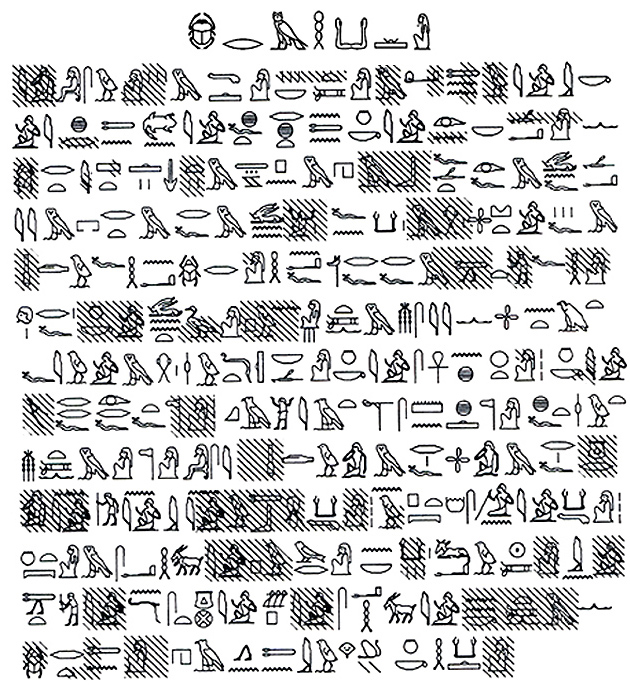
Coffin Texts,
spell 261 (III, 382 - 389), Middle Kingdom (ca. 1938 - 1759 BCE) -
text in coffin of Asyut (Cairo 36444) and in inner coffin of Msht
(Cairo 28118) - hieroglyphic text in
Buck, de, 1935-1961 - see also :
Heka.
TO BECOME A MAGICIAN.
"O You nobles who are in the presence of Lord Atum, behold, I
have come to You ! Fear me in proportion with what You know !
It is I
whom the Sole Land made before there came into being the two meals on
Earth ; when he sent forth his sole eye ; when he was alone, going
forth from his own
mouth ; when his million Kas were there, the protection of his companions
; when he spoke with Khepri, with him, over whom he rules
; when he took Hu upon his speech.
It is I who am the very son of Who-bore-Atum, born before he had a
mother.
I am under the protection of the command of the Sole Lord.
It is I who give life to the Ennead.
It is I who act as he pleases, father of gods, lofty of standard, who
make the
gods effective in accordance with the command of Who-bore-Atum.
The august
god who eats and speaks with his mouth.
I have kept silence, I have bowed down, I have come shod, O Bulls of the Sky, I have seated myself,
O Bulls of Nut, in this my dignity of 'Greatest of Lords of Kas'. Heir of Atum.
I have come, so that I may take possession of my throne and that I may
gather unto me
my dignity, for all was mine before You came into being, You
gods. Go down upon your haunches ! For I am a magician !"
Atum's autogenous activity, the presence ex nihilo of the Great
One, does not change Nun. Atum's splitting and the emergence of the divine
mind and its Ennead, has no effect on Nun. The risen land and the
petrified Sun-ray are realized without altering, transforming or
transmuting Nun. This is Nun's everlastingness and inert solidity. This is
the lifeless, dark bedrock of creation, unfettered by the limitations of time
and the cycle of dawn, culmination, dusk and night of Atum-Re. Atum appears at the
first occurrence and differentiates into the divine ideas of all possible
creations and manifests creation itself.
The divine names constitute the Pleroma of precreation. They represent Atum's
eternity and dynamic creativity. The divine drama unfolds in the "zep
tepi" and timelessness is the key to an understanding of eternity. This
temporal series is not linear, but cyclic. An eternity of cycles ensue,
the eternal recurrence of the "time of the gods", an infinite number of
combinations of a fundamental set of nine principles plus one (the "10th"
or Horus-Re-Pharaoh). All of these operate
within the margins set by order and justice (truth - Maat).
In precreation, Nun and Atum communicate, but without ever changing their
nature. Everlastingness cannot be other than stable, enduring and
unchanging. Although Atum is, given Nun, presupposed (otherwise he would
not be autogenous), his creation is, in a fundamental way, influenced by
Nun. Firstly, because the parameters of creation include disorder (Seth,
Apophis) and secondly, because Re regenerates when uniting with the
corpse of Osiris (linked with Nun - cf. the 6th Hour of the
Amduat).
To enter the "zep tepi" and its regenerative powers, the deepest, darkest and deadliest point of creation
is sought. A
direct but balanced confrontation between divine order and disorder
(symmetry and symmetry-break) is present in Egyptian thought. Two
examples.
The entry of Seth disrupts the triadic unfoldment of the Ennead. Indeed,
even in the Pleroma of the deities a chaotic, transgressing and
harmful factor is introduced. Disorder is not excluded, on the contrary,
considered before singularity. Disorder and singularity are both
precreational, and in the "zep tepi", the divine differentiation out of
firstness, disorder is again present. Seth disrupts the natural flow, puts
in hinderances, transgresses, fights and is punished (namely to serve Re
for all of eternity). In the moral routines
contemplated by Atum for his creation, the
drama of the last generation of the gods incorporates murder in the divine plot
! The "golden age" of the gods is over and the disrupted state has to be
rectified.
This is realized by and balances out against the rectitude of the Pharaonic State, or Mighty
Horus Incarnate, the "10th", or the completion of the Ennead in
manifest actuality (the restoration of the time of the gods on Earth).
Horus is abused by
Seth, avenges his murdered father Osiris by fighting his uncle and is proclaimed King of Egypt
by the Ennead.
Another example is the daily confrontation between Re & Apophis. Utter
destruction is ever-present. There is no time for complacency. However,
because Horus is King, Seth has to protect Re, for even Seth obeys the
Enneads. As Great Dark Sorcerer, he is the only one able to rule the
gigantic snake of Nun, undermining the fabric of creation from within. If
Seth disrupts, Apophis annihilates. In the VIIth Hour of every night, Apophis gulps down the Nile, leaving the Bark of Re on dry
sand. But because Seth, the god of evil ("isefet"), rules Apophis and has been placed
in the service of Re (namely to destroy the latter's enemies), Re is able to continue his journey and
rise at dawn. By simultaneously separating and binding order and chaos, checks and
balances are ongoing and
a good balance is achieved.
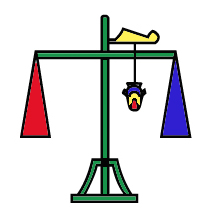
"Said he (Anubis) that is in the tomb :
'Pay attention to the decision of
truth
and the plummet of the balance, according to its stance !'"
Papyrus of Ani, Plate 3 - ca. 1250 BCE - XIXth Dynasty - British Museum
Is the Egyptian image of precreation, to be found as early as the
Pyramid Texts or the Coffin Texts, not evoked in Genesis
?
"And the Earth was without without form and void
; and darkness was upon the face of the abyss. And the spirit of Elohim
moved upon the face of the waters.
Genesis,
1:2 -3.
Does this verse not imply precreation ? Is the word "Earth" not in
contradiction with its adjectives, formlessless and void ?
Substituting Earth for "Nun", a clear picture emerges : before creation
started there is darkness, formless, void and this in all directions,
as deep as possible. This abyss is liquid. On these formless waters,
Atum "moved" and "uttered" the 10 Words of Creation ...
|

![]()
![]()
